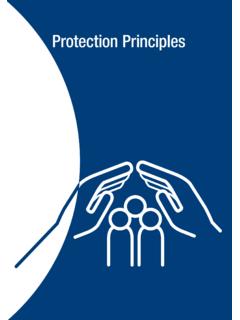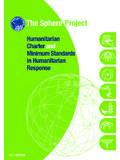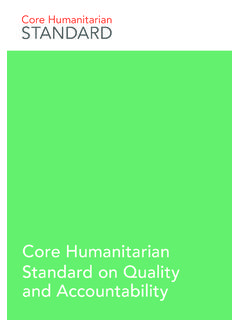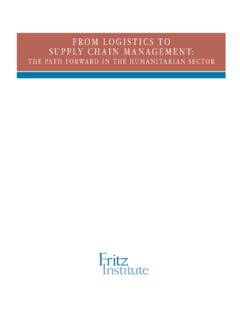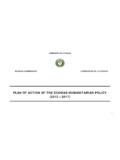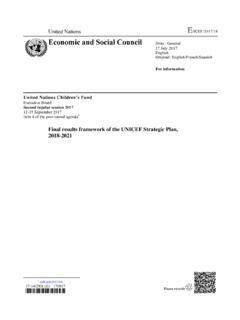Transcription of The Core Standards - Sphere Handbook
1 The core StandardsHumanitarian Charter and Minimum Standards in humanitarian Response50 The core Standards are essential process Standards shared by all sectors. They provide a single reference point for approaches that underpin all the Standards in the Handbook . Each chapter, therefore, requires the companion use of the core Standards to help attain its own are six core Standards :People-centred humanitarian responseCoordination and collaborationAssessmentDesign and responsePerformance, transparency and learningAid worker performanceEach core Standard is structured as follows: The core Standard: It is qualitative in nature and specifies the level to be attained in humani-tarian response Key actions: These are suggested activities and inputs to help meet the Standards Key indicators.
2 These are signals that show whether a standard has been attained They provide a way of measuring and communicating the processes and results of key actions; they relate to the minimum standard, not to the key action Guidance notes: These include specific points to consider when applying the core Standard, key actions and key indicators in different situations They provide guidance on tackling prac-tical difficulties, benchmarks or advice on priority issues They may also include critical issues relating to the Standards , actions or indicators, and describe dilemmas, controversies or gaps in current knowledge The key indicators of the core Standards accommodate wide variations in a user s application and context Measurable and time-bound specifications for each indicator are highly context- and sector-specific Users should therefore adapt the key indicators to their particular situation.
3 As appropriate A select list of references and further reading is included at the end of this chapter How to use this chapter51 The core StandardsContentsIntroduction 53 The core Standards 55 References and further reading 74 humanitarian Charter and Minimum Standards in humanitarian Response52 core StandardsStandard 1 People-centred humanitarian responseStandard 4 Design and responseStandard 2 Coordination and collaborationStandard 5 Performance, transparency and learningStandard 3 AssessmentStandard 6 Aid worker performanceReferences and further readingHumanitarian CharterProtection Principles53 The core StandardsIntroductionThe core Standards describe processes that are essential to achieving all the Sphere minimum Standards .
4 They are a practical expression of the principles of the Sphere humanitarian Charter and are fundamental to the rights of people affected by conflict or disaster to assistance that supports life with dignity. The core Standards define the minimum level of response to be attained (as signalled by the key indicators) by humanitarian agencies, be they community-based, local, national or core Standards are also linked to other key accountability initiatives, promoting coherence and reinforcing a shared commitment to accountability. For example, the humanitarian Accountability Partnership (HAP) 2010 Standard in Accountability and Quality Management benchmarks and the core Standards contain complementary requirements.
5 The aid worker performance standard is coherent with People In Aid s Code of Good Practice. The Good Enough Guide of the Emergency Capacity Building (ECB) Project, Groupe URD s Quality Compas and the Active Learning Network for Accountability and Performance in humanitarian Action (ALNAP) inform core Standards 1 and 5 in particular. The core Standards are a companion to the Foundational Standards in the INEE (Inter-Agency Network for Education in Emergencies) Minimum Standards for Education: Preparedness, Response, importance of the core Standards for all sectorsThe first core Standard recognises that the participation of disaster-affected people women, men, girls and boys of all ages and their capacity and strate-gies to survive with dignity are integral to humanitarian response.
6 core Standard 2 addresses the need for an effective response to be coordinated and imple-mented with other agencies and governmental authorities engaged in impartial humanitarian Standard 3 describes the need for assessments systematically to under-stand the nature of the disaster, identify who has been affected and how, and assess people s vulnerability and capacities. It acknowledges the critical impor-tance of understanding need in relation to the political, social, economic and envi-ronmental context and the wider population. Agencies meeting core Standard 4 humanitarian Charter and Minimum Standards in humanitarian Response54design their response based on an impartial assessment of needs, addressing unmet needs in relation to the context and capacity of affected people and states to meet their own Standard 5 is attained by agencies that continually examine the effective-ness, quality and appropriateness of their response.
7 Agencies adapt their strat-egies in accordance with monitoring information and feedback from people affected by disaster, and share information about their performance. They invest in unbiased reviews and evaluations and use the findings to improve their policy and Standard 6 recognises that humanitarian agencies have an obligation to disaster-affected people to employ aid workers with the appropriate knowledge, skills, behaviour and attitudes to deliver an effective humanitarian response. Equally, agencies are responsible for enabling aid workers to perform satisfacto-rily through effective management and support for their emotional and physical s focus is on meeting the urgent survival needs of people affected by disaster or conflict.
8 However, the core Standards can also support disaster preparedness and approaches that reduce future risk and vulnerability, enhance capacity and promote early recovery. Such approaches take account of the impact of the response on the natural environment and broader context and are highly relevant to the needs of the host and wider the Handbook , vulnerable refers to people who are especially susceptible to the effects of natural or man-made disasters or of conflict. People are, or become, more vulnerable to disasters due to a combination of physical, social, environmental and political factors.
9 They may be marginalised by their society due to their ethnicity, age, sex, disability, class or caste, political affilia-tions or religion. A combination of vulnerabilities and the effect of an often volatile context all contribute to people being vulnerable for different reasons and in different ways. Vulnerable people, like all those affected by disaster, have various capacities to manage and recover from disasters. A thorough understanding of vulnerable people s capacities and the barriers they may face in accessing humanitarian support is essential for a response that meets the needs of those who need it core StandardsThe core StandardsCore Standard 1.
10 People-centred humanitarian responsePeople s capacity and strategies to survive with dignity are integral to the design and approach of humanitarian actions (to be read in conjunction with the guidance notes) Support local capacity by identifying community groups and social networks at the earliest opportunity and build on community-based and self-help initia-tives (see guidance note 1). Establish systematic and transparent mechanisms through which people affected by disaster or conflict can provide regular feedback and influence programmes (see guidance note 2). Ensure a balanced representation of vulnerable people in discussions with the disaster-affected population (see guidance note 3).





